Allegri’s adaptations win high class encounter
Allegri’s Juventus hosted Sarri’s Napoli in the first leg of the Coppa Italia semi-final on Tuesday night. With both sides and coaches being amongst the strongest in Europe tactically, the clash was eagerly anticipated. What followed was a high class encounter, in keeping with the clashes between the teams over the last two seasons.
Napoli’s adapted press
In their usual base 4-1-4-1 defensive shape against Juventus’ back 3 and wing-backs, Sarri had to find a way to keep pressure on their first line of build-up to neutralise the overload. But had to combine this with not exposing the shape to the wing-backs and allowing easy progressions up the wing.
The answer came in the form of diagonal pressing from the wingers, Callejon and Insigne. When Juventus’ side backs, Chiellini or Barzagli had the ball, Napoli’s ball-near winger would move diagonally to press them. This allowed them to block the ground pass to the wing-back. Whilst this may seem rather counterintuitive since most modern pressing schemes are based on forcing opponents to the wings early, it was important in terms of access and stopping progression.
Juventus’ wing-backs were the players that enjoyed the most space from opponents. This is because Napoli’s wingers were responsible for either pressing the first line or joining the other midfielders to block the centre and the full-backs kept connected to the defensive line. As such, easy ground passes to Asamoah and L.ichsteiner would allow them to break Napoli’s access, and use the time on the ball to force the Southern Italians into deep positions.
This diagonal pressing was part of a pressing scheme that aimed to force turnovers in one of two ways. If the Juventus side backs (Chiellini and Barzagli) responded by dribbling or passing into the centre, Napoli could use their compactness to press and win the ball back. Alternately, the Juventus defenders could attempt to bypass the diagonal pressing with lofted passes to the wing-backs. This would give time for the Napoli full-back to move up and press the wing-back upon receiving the ball. The pressure could be further intensified, with the nearby Napoli winger pressing backwards to close the exit routes.
Milik’s role in the pressing was dependent on the phase of the Juventus build-up as well as who had the ball. In Juventus’ early build-up the Polish striker would press Juventus’ side backs from a sideways position, when combined with the Napoli wingers’ diagonal press this could force Juventus into the high pressure centre.
When Juventus circulated the ball along their backline in positions closer to the halfway line, Milik would focus on blocking the routes into midfield. When Bonucci had the ball, he would press forwards whilst blocking the ball-near 6 (Khedira or Pjanic). When Juve’s side backs had the ball, he would drop slightly and take up a position between Khedira and Pjanic, giving him access if either of them received the ball.
Bonucci-led-Juve’s ways against the press
In the same manner that previous knowledge assisted Sarri in adapting his pressing scheme, Allegri would have been aware of the likely manner Napoli would press in and prepared ways to beat it.
One of the major tools that adds variability to Juventus’ build-up is the excellent passing range of Leonardo Bonucci. His ability to play lofted passes into depth out wide, or flat laser passes into forwards beyond lines of oppositional defence are a great tool. Much of the home side’s approach in breaking the press was based around the defender’s passing skills.
One way Juventus aimed to beat Napoli’s pressing, was to move the ball across the backline to get Bonucci free for enough time to bypass pressure with direct passes to the forwards. At times there were open spaces between Napoli midfielders during their shifting, that allowed Bonucci to make these passes close to the ground and easier for the strikers to control.
On other occasions these passes had to be made aerially due to Napoli’s cover of the centre. In these situations he tended to aim for Mandzukic who could use his aerial superiority over Maggio to flick the ball on for Asamoah.
Whilst these methods were occasionally effective, they were not consistent enough to be relied upon. The reliance on longer passes was a cause of this inconsistency along with a weak structure for layoffs when the strikers received the ball. These factors were part of an average start to the game for Allegri’s men.
Allegri adapts build-up shape
It was likely this dissatisfaction that led to Allegri adapting his side’s build-up positioning after around 30 minutes, to create more consistent ways of progressing against Napoli’s press.
The home side switched to a back 4 in build-up which created different dynamics, and had implications on Napoli’s way of pressing against it. Within this back 4, Barzagli and Asamoah would act as full-backs, occupying a higher line than the centre backs.
This created an asymmetric shape from Juventus. On the left Asamoah occupied the whole flank alone, trying to divide his duties between left back and left winger. As such he would often move high on the wing to give offensive width. On the right, the home side had a double wing occupation, with Barzagli as a right back and Lichsteiner as a right winger ahead of him.
Juventus’ new positioning caused a different pressing approach from their opponents. When pressing Chiellini (Juventus’ right side) Callejon would make the same diagonal pressing run as previously. Against Bonucci however, Hamsik would now push forwards to press from the centre. Insigne could no longer press in the previous manner with the threat of both Barzagli and Lichsteiner outnumbering Strinic behind him.
Juventus were now able to progress more frequently, on the right Barzagli was often free to receive short passes from Bonucci and able to play up the line into Lichsteiner. Whilst there were still some issues in support for the Suiss international, but it was overall less problematic than before.
On the left Chiellini was at times able to open the passing route to Asamoah by dribbling forwards against the grain of Callejon’s press. In these situations Napoli were not quick enough to collapse on the ball and prevent Chiellini breaking their access.
Napoli manipulating man-orienations
Allegri’s Juventus, like several Italian sides, defend in a man-oriented fashion. Their defensive scheme is nuanced enough to combine man-orientations for access on the ball side with ball-far players defending zonally to retain an element of compactness. Last season, Sarri’s Napoli struggled in several games against man-oriented opponents, and that has been one of the factors they have improved hugely this season. However in the earlier clash this season, they were still largely unable to make their possession game effective.
Despite some issues, Napoli demonstrated various ways of creating separation from Juventus’ man-oriented coverage and using it to their advantage. For clarity I’ve listed the main methods used, before going into more detail on them.
- Opening the route onto the next line & curved movement to receive 3rd man pass.
- Switch to open man, then combining past incoming pressure.
- Opening valuable spaces, then filling it dynamically.
- Vertically opposite movements. (group-tactical)
- Double movements. (individual)
Opening routes onto the next line/3rd man
This scheme is in line with a general heuristic Napoli’s midfielders can be seen acting by, namely; players who are covered moving further upfield, whilst others drop to create a different route. In a number of cases, when the likes of Rog and Hamsik were covered by an opponent they would move wider taking their opponent with them. Through the Juventus man following, this opened the passing lane to a player positioned further up the field who could drop slightly to receive the ball.
The receiver would of course be followed by his own man-oriented opponent so they would need support to move the ball if the attack was to advance, in this scheme this would be provided by the initial player who opened the passing route. After moving wide, they would make a curved run forwards to receive the ball and break through the man-oriented coverage. The initial pass onto the next line was enough to distract the initial Juve marker, and create the free man to break through the home side’s structure.
Switch to open man
As mentioned earlier, Juventus’ defensive scheme works with man-orientations on the ball side and zonal coverage from the ball-far players. This meant the Napoli players on the ball-far side had the biggest distances to their opponents, and they could be easily accessed with switches. As the nearby Juventus players moved across to create access, Napoli would use quick one-twos to combine their way past the pressure, and break through towards the byline. This was often done with switches towards Maggio and led to a couple of Napoli’s most dangerous chances in the early part of the half, with one-two combinations past the onrushing Asamoah.
Opening valuable space & filling it
Dynamic space occupation is a common way of playing against man-oriented defending, it is a rather natural result of players trying to get free from their opponents. However it is likely to most consistently advantageous when done in an intelligent manner.
There were a number of instances of Napoli’s man-marked players dropping out of the centre to take their marker away and open space in valuable areas. The same players at times moved back into this space to receive the ball, since they began their run earlier than their opponent they could move into the space and utilise their dynamic advantage to receive the ball. Hamsik was particularly adept at this, moving deep in the left half space before driving forwards to take advantage of the open centre. This was particularly useful when synchronised with movements by his team-mates that helped to ensure the home side vacated the centre of the field.
Vertically opposite movements
As a specific and co-ordinated type of dynamic space occupation these movements often had very positive effects in creating gaps within Juventus’ structure. As the term suggests, vertically opposite movements is when two or more team-mates move in opposite directions.
This type of movement can be so effective at creating a free man since it challenges the speed at which the opponents can re-orient themselves to the moving opponents. These movements often lead to no pressure on the dropping player, and Insigne often benefitted from this to receive the ball with space in front of the home side’s back line. With players like Milik and Strinic threatening the space behind Juve’s defence, they often deepened the positioning of their original marker, as well as preventing Insigne’s marker from moving up.
Double movements
This scheme had similar effects to the vertically opposite movements, but can be distinguished based on the level they take place at. Although they often occur simultaneously, double movements here refer to the individual process of moving in one direction before quickly changing whilst vertical opposites refers to a group-tactical process.
Players like Milik and Insigne benefitted from these double movements frequently to receive the ball with brief time periods of no pressure. These double movements take advantage of the reactive nature of man-marking to create separation by virtue of starting movements earlier than opponents, as well as moving the opponent in the opposite area in which they intend to receive the ball.
A number of these factors could be seen in the lead up to Napoli’s superb opening goal.
Adapted structure & Dybala’s role
At the interval Allegri brought on Cuadadro in place of Lichsteiner for a more offensive presence on the right flank. He also adapted the positional structure and this was a large part of Juventus’ improved second half performance. In possession, the home side would now operate in an asymmetric 4-3-3 type shape. This led to a number of adapted roles, Pjanic acted more as a lone 6 and often dropped to assist the centre-backs in build-up. Cuadadro on the right provided offensive width and offered depth with diagonal runs behind Napoli’s defensive line. Most importantly however, was the role of Dybala as a roaming 8 from a nominal position in the right half space.
The diminutive Argentinean was often found occupying the space between Napoli’s midfield and defensive lines in the right half space, a position from which he achieved numerous things with the potential for even more. Playing in space between 3 or 4 opponents, Dybala could offer routes to progress for the likes of Bonucci. His press resistance ensured he retained the ball in these situations and could connect the play to Cuadadro on the right. Alternately, he could influence Insigne and Strinic to occupy narrower positions freeing the direct pass from Bonucci to Cuadadro.
In the final 3rd he was free to roam and was often seen in the opposite half space having similar effects and giving depth to the structure with runs in behind. One aspect of his positioning that was not utilised was the potential for diagonal dribbles from his right half space position towards goal. These could have been part of a stronger offensive dynamic, particularly if combined with opposite movements from the likes of Higuain.
Juventus profit from Napoli’s weakening press
Another aspect behind Juventus’ improved 2nd half was the improved ability to beat the press in a consistent manner. A large part of this was due to a weakening intensity from Sarri’s side which manifested in slower shifts from the midfield. When combined with the diagonal pressing movement from Callejon and Insigne, this resulted in momentarily open half spaces, allowing the likes of Mandzukic and Dybala to receive passes from the defenders.
This helped Allegri’s men set up better wing attacks, since they were able to create more space for the likes of Cuadadro and Asamoah by drawing Napoli’s players infield towards the ball before playing out wide.
Napoli’s execution weakens
In the first half Sarri’s men put in a strong display of offensive dynamics to beat man-orientations, however their execution was weakened in the second half. Their attempts to break through were often in a 3rd man basis, with Hamsik making 3rd man underlapping runs through the left half space when passes were exchanged on the left flank. However, the execution of the last pass was far weaker with a number of technical errors made under pressure from Juventus’s defenders.
Another factor behind this was a different defensive performance from Juventus in line with the game state. With Juventus ahead they could afford to defend in a more passive and position-oriented zonal manner, within their 4-4-2 shape. This resulted in greater compactness and better timed advances to press the ball. As such, Napoli found it harder to draw Juventus in to press and use their combinations to break through.
Conclusion
Allegri and Juventus deserve great credit for the adaptations that led to the much improved second half display and comeback. With a 3-1 lead ahead of the second leg at the San Paolo they are in a strong position to advance to the final of the Coppa Italia. Interestingly, none of the 3 goals were directly linked to the improvements, with a mixture of incorrect refereeing decisions and Reina’s mistake(s?) giving them a helping hand.
This game marks the start of a tough run of fixtures for Sarri’s side, with Roma and Real Madrid up next before consecutive clashes against Juventus to come in around a month’s time. These fixtures will likely decide the success of Napoli’s season. After the 1st legs, Napoli don’t appear to be in a strong position against Real or Juventus. However, both 2nd legs being at home as well as away goals, give them the chance for a comeback.

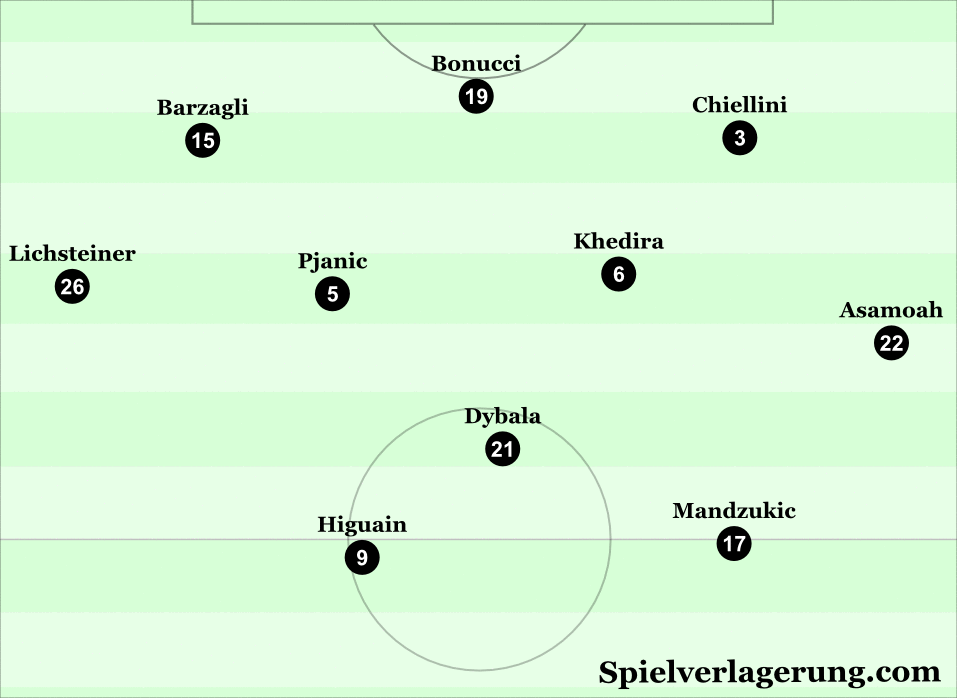
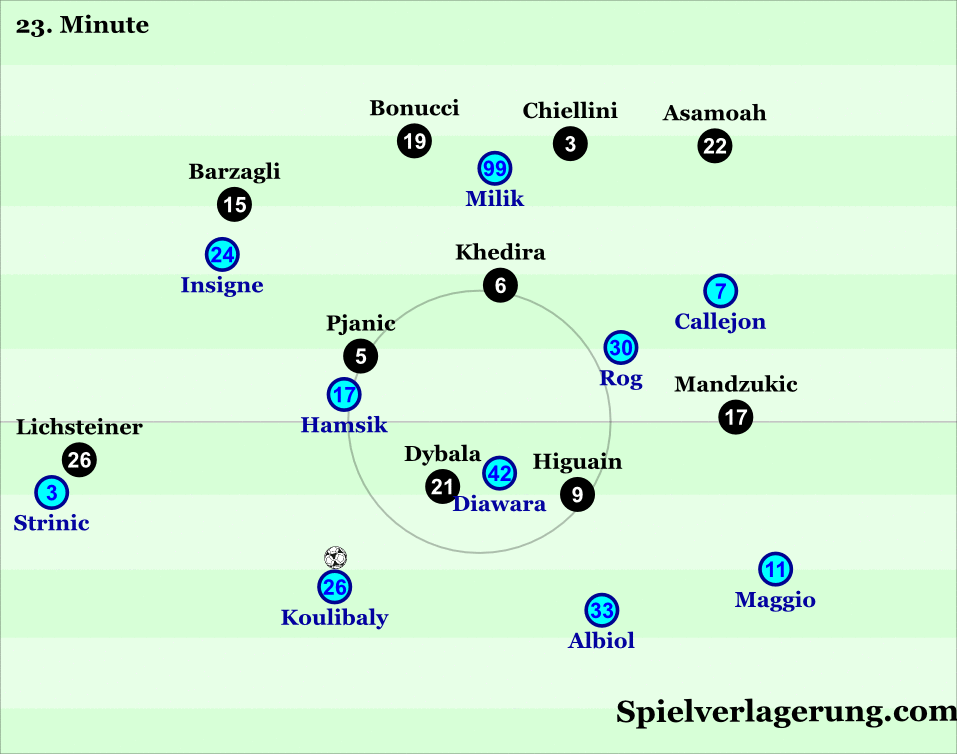
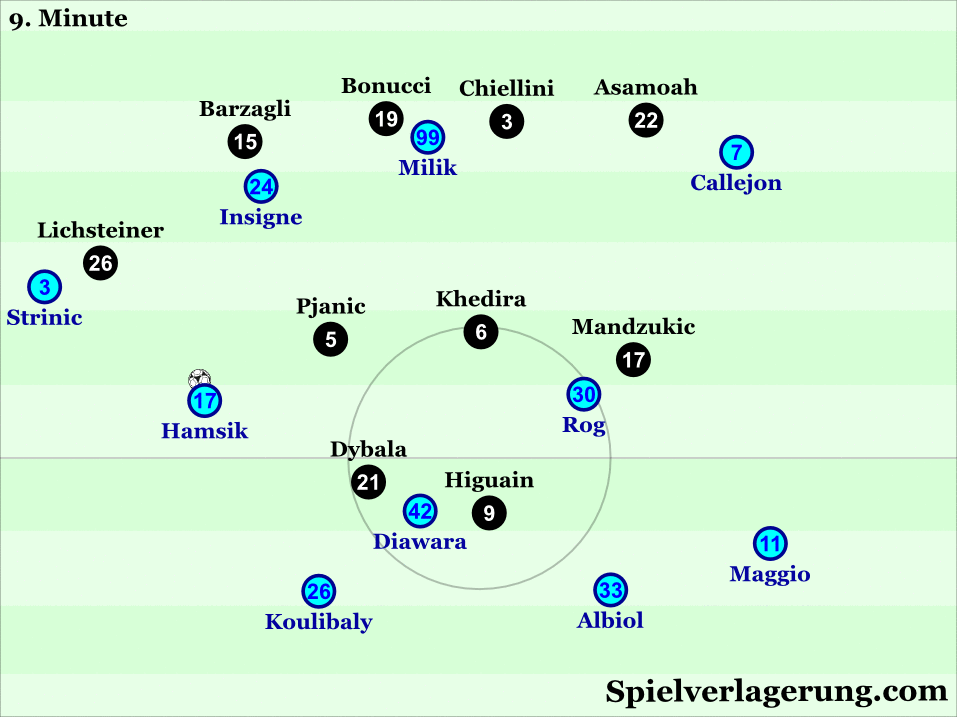
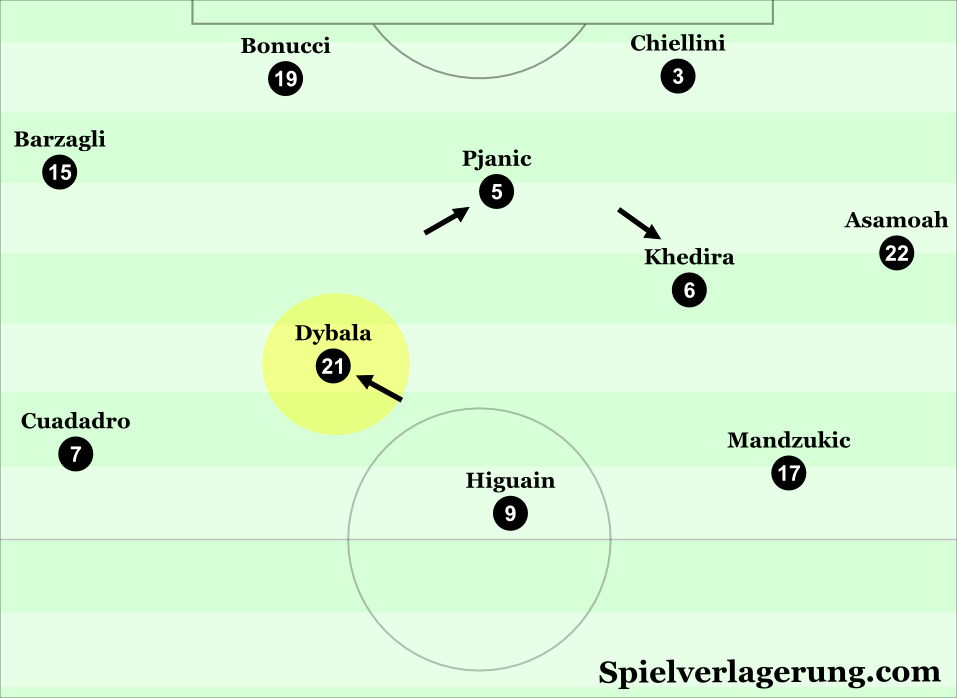
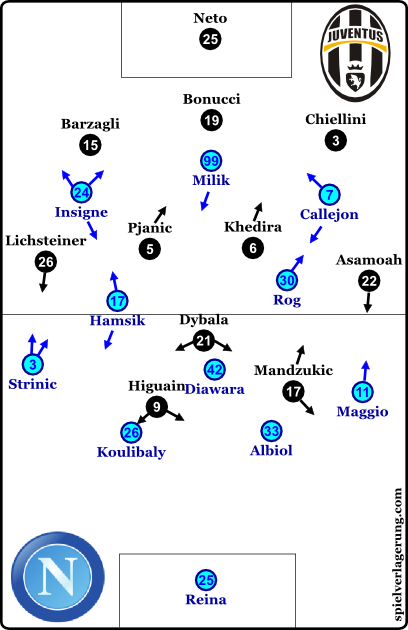
Keine Kommentare vorhanden Alle anzeigen